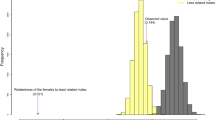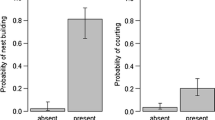Abstract
Fecundity is an important component of fitness. In cooperatively breeding species, studies aimed at understanding the factors that affect fecundity have largely been restricted to species that exhibit high reproductive skew, where reproduction is monopolised by a few individuals. In such species, dominant suppression and inbreeding avoidance are the principal explanations for low fecundity in subordinate females. In this paper, we evaluate the relative effects of individual, social, and environmental factors on female fecundity in a low skew cooperative breeding mammal: the banded mongoose (Mungos mungo). Most females (80%) conceived in each breeding event, and most pregnant females (93%) carried their litter to term. The principal determinants of a female’s fecundity were intrinsic qualities, particularly age and body size. However, there was no evidence of dominant suppression of subordinate reproduction or inbreeding avoidance. Similarly, there was little indication that social or environmental factors influence fecundity. We suggest that in the banded mongoose, the apparent lack of costs to inbreeding, and the absence of dominant female suppression of reproduction in other females result in low reproductive skew. Indeed, in banded mongooses, like lions (Felis leo), multiple breeding may be a consequence of benefits to rearing young communally.







Similar content being viewed by others
References
Berger J (1992) Facilitation of reproductive synchrony by gestation adjustment in gregarious mammals—a new hypothesis. Ecology 73:323–329
Cant MA (1998) Communal breeding in banded mongooses and the theory of reproductive skew. PhD Dissertation. University of Cambridge
Cant MA (2000) Social control of reproduction in banded mongooses. Anim Behav 59:147–158
Cant MA, Johnstone RA (1999) Costly young and reproductive skew in animal societies. Behav Ecol 10:178–184
Cant MA, Otali E, Mwanguhya F (2001) Eviction and dispersal in co-operatively breeding banded mongooses (Mungos mungo). J Zool 254:155–162
Cant MA, Otali E, Mwanguhya F (2002) Fighting and mating between groups in a cooperatively breeding mammal, the banded mongoose. Ethology 108:541–555
Clarke FM, Faulkes CG (1997) Dominance and queen succession in captive colonies of the eusocial naked mole-rat, Heterocephalus glaber. Proc R Soc Lond B 264:993–1000
Clutton-Brock TH (1988) Reproductive success: studies of individual variation in contrasting breeding systems. Chicago University Press, Chicago
Clutton-Brock TH (1998) Reproductive skew, concessions and limited control. Trends Ecol Evol 13:288–292
Clutton-Brock TH, Guinness FE, Albon SD (1983) The costs of reproduction to red deer hinds. J Anim Ecol 52:367–383
Clutton-Brock TH, Brotherton PNM, Russell AF, O’Riain MJ, Gaynor D, Kansky R, Griffin A, Manser M, Sharpe L, McIlrath GM, Small T, Moss A, Monfort S (2001a) Cooperation, control, and concession in meerkat groups. Science 291:478–481
Clutton-Brock TH, Russell AF, Sharpe LL, Brotherton PNM, McIlrath GM, White S, Cameron EZ (2001b) Effects of helpers on juvenile development and survival in meerkats. Science 293:2446–2449
Cockburn A (1998) Evolution of helping behavior in cooperatively breeding birds. Annu Rev Ecol Sys 29:141–177
Cooney R, Bennett NC (2000) Inbreeding avoidance and reproductive skew in a cooperative mammal. Proc R Soc Lond B 267:801–806
Creel SR, Waser PM (1991) Failures of reproductive suppression in dwarf mongooses (Helogale parvula): accident or adaptation? Behav Ecol 2:7–15
Creel SR, Waser PM (1997) Variation in reproductive suppression among dwarf mongooses: interplay between mechanisms and evolution. In: Solomon NG, French JA (eds) Cooperative breeding in mammals. Cambridge University Press, Cambridge, pp 150–170
Creel S, Creel N, Wildt DE, Monfort SL (1992) Behavioral and endocrine mechanisms of reproductive suppression in Serengeti dwarf mongooses. Anim Behav 43:231–245
De Luca DW, Ginsberg JR (2001) Dominance, reproduction and survival in banded mongooses: towards an egalitarian social system? Anim Behav 61:17–30
Elston DA (1998) Estimation of denominator degrees of freedom of F-distributions for assessing Wald statistics for fixed-effect factors in unbalanced mixed models. Biometrics 54:1085–1096
Emlen ST (1991) Evolution of cooperative breeding in birds and mammals. In: Krebs JR, Davies NB (eds) Behavioural ecology: an evolutionary approach, 3rd edn. Blackwell, Oxford, pp 301–337
Emlen ST (1997) Predicting family dynamics in social vertebrates. In: Krebs JR, Davies NB (eds) Behavioural ecology: an evolutionary approach, 4th edn. Blackwell, Oxford, pp 228–253
Faulkes CG, Abbott DH (1997) The physiology of a reproductive dictatorship: regulation of male and female reproduction by a single-breeding female in colonies of naked mole-rats. In: Solomon NG, French JA (eds) Cooperative breeding in mammals. Cambridge University Press, Cambridge, pp 268-301
Faulkes CG, Bennett NC (2001) Family values: group dynamics and social control of reproduction in African mole-rats. Trends Ecol Evol 16:184–190
French JA (1997) Singular breeding in callitrichid primates. In: Solomon SG, French JA (eds) Cooperative breeding in mammals. Cambridge University Press, Cambridge, pp 34–75
Gilchrist JS (2001) Reproduction and pup care in the communal breeding banded mongoose. PhD Dissertation, University of Cambridge
Gilchrist JS (2004) Pup escorting in the communal breeding banded mongoose: behavior, benefits, and maintenance. Behav Ecol DOI 10.1093/beheco/arh071
Gilchrist JS, Otali E (2002) The effects of refuse-feeding on home-range use, group size, and intergroup encounters in the banded mongoose. Can J Zool 80:1795–1802
Grafen A (1990) Biological signals as handicaps. J Theor Biol 144:517–546
Hayes LD (2000) To nest communally or not to nest communally: a review of rodent communal nesting and nursing. Anim Behav 59:677–688
Hill RA, Lycett JE, Dunbar RIM (2000) Ecological and social determinants of birth intervals in baboons. Behav Ecol 11:560–564
Hoogland JL (1995) The black-tailed prairie dog: social life of a burrowing mammal. University of Chicago Press, Chicago
Jakob E, Marshall S, Uetz G (1996) Estimating fitness: a comparison of body condition indices. Oikos 77:61-67
Jamieson IG (1997) Testing reproductive skew models in a communally breeding bird, the pukeko, Porphyrio porphyrio. Proc R Soc Lond B 264:335–340
Jennions MD, Macdonald DW (1994) Cooperative breeding in mammals. Trends Ecol Evol 9:89–93
Johnstone RA (2000) Models of reproductive skew: a review and synthesis (invited article). Ethology 106:5–26
Keane B, Creel SR, Waser PM (1996) No evidence of inbreeding avoidance or inbreeding depression in a social carnivore. Behav Ecol 7:480–489
Keller L, Perrin N (1995) Quantifying the level of eusociality. Proc R Soc Lond B 260:311–315
Keller L, Reeve HK (1994) Partitioning of reproduction in animal societies. Trends Evol Ecol 9:98–103
Kirkpatrick M, Jarne P (2000) The effects of a bottleneck on inbreeding depression and the genetic load. Am Nat 155:154–167
Koenig WD, Haydock J, Stanback MT (1998) Reproductive roles in the cooperatively breeding acorn woodpecker: Incest avoidance versus reproductive competition. Am Nat 151:243–255
Kruuk LEB, Clutton-Brock TH, Albon SD, Pemberton JM, Guinness FE (1999) Population density affects sex ratio variation in red deer. Nature 399:459–461
Lewis SE, Pusey AE (1997) Factors influencing the occurrence of communal care in plural breeding mammals. In: Solomon NG, French JA (eds) Cooperative breeding in mammals. Cambridge University Press, New York, pp 335-360
Lock JM (1977) The vegetation of Rwenzori National Park, Uganda. Bot Jahrb Syst Pflanzengesch Pflanzengeogr 98:372–448
Malcolm JR, Marten K (1982) Natural selection and the communal rearing of pups in African wild dogs, Lycaeon pictus. Behav Ecol Sociobiol 10:1–13
McRae SB (1996) Family values: costs and benefits of communal nesting in the moorhen. Anim Behav 52:225–245
O’Riain MJ, Bennett NC, Brotherton PNM, McIlrath G, Clutton-Brock TH (2000) Reproductive suppression and inbreeding avoidance in wild populations of co operatively breeding meerkats (Suricata suricatta). Behav Ecol Sociobiol 48:471–477
Ostfeld RS, Canham CD (1995) Density dependent processes in meadow voles—an experimental approach. Ecology 76:521–532
Otali E, Gilchrist JS (2004) Effects of refuse feeding on body condition, reproduction and survival of banded mongooses. J Mammal 85:491–497
Packer C, Collins DA, Sindimwo A, Goodall J (1995) Reproductive constraints on aggressive competition in female baboons. Nature 373:60–63
Packer C, Pusey AE, Eberly LE (2001) Egalitarianism in female African lions. Science 293:690–693
Reeve HK, Sherman PW (1991) Intracolonial aggression and nepotism by the breeding female naked mole-rat. In: Sherman PW, Jarvis JUM, Alexander RD (eds) The biology of the naked mole-rat. Princeton University Press, Princeton, N.J., pp 337–357
Reeve HK, Emlen ST, Keller L (1998) Reproductive sharing in animal societies: reproductive incentives or incomplete control by dominant breeders? Behav Ecol 9:267–278
Reyer HU, Dittami JP, Hall MR (1986) Avian helpers at the nest: are they psychologically castrated? Ethology 71:216–228
Rood JP (1974) Banded mongoose males guard young. Nature 248:176–177
Rood JP (1975) Population dynamics and food habitats of the banded mongoose. E Afr Wildl J 13:89–111
Russell AF, Brotherton PNM, McIlrath GM, Sharpe LL, Clutton-Brock TH (2003) Breeding success in cooperative meerkats: effects of helper number and maternal state. Behav Ecol 14:486–492
Schaik CP van (1983) Why are diurnal primates living in groups? Behaviour 87:120–144
Schall R (1991) Estimation of generalised linear models with random effects. Biometrika 78:719–727
Sokal RR, Rohlf FJ (1995) Biometry: the principles and practice of statistics in biological research, 3rd edn. Freeman, New York
Solomon NG, French JA (1997) Cooperative breeding in mammals. Cambridge University Press, Cambridge
Stacey PB, Koenig WD (1990) Cooperative breeding in birds: long-term studies of ecology and behavior. Cambridge University Press, Cambridge
Waser PM, Austad SN, Keane B (1986) When should animals tolerate inbreeding. Am Nat 128:529–537
Wasser SK, Barash DP (1983) Reproductive suppression among female mammals: implications for biomedicine and sexual selection theory. Q Rev Biol 56:513-538
Acknowledgements
We thank the following for advice, or for comments on the manuscript: Andy Russell, Tim Clutton-Brock, Tim Coulson, Mike Cant, and the anonymous reviewers. We are grateful to the Uganda Wildlife Authority for allowing us to conduct our research in Queen Elizabeth National Park. For financial support, J.S.G. thanks the Biotechnology and Biological Sciences Research Council, the Ian Karten Charitable Trust, and in Cambridge: Magdalene College, the Board of Graduate Studies, the Cambridge Philosophical Society, and the Department of Zoology.
Author information
Authors and Affiliations
Corresponding author
Additional information
Communicated by F. Trillmich
Rights and permissions
About this article
Cite this article
Gilchrist, J.S., Otali, E. & Mwanguhya, F. Why breed communally? Factors affecting fecundity in a communal breeding mammal: the banded mongoose (Mungos mungo). Behav Ecol Sociobiol 57, 119–131 (2004). https://doi.org/10.1007/s00265-004-0837-y
Received:
Revised:
Accepted:
Published:
Issue Date:
DOI: https://doi.org/10.1007/s00265-004-0837-y




